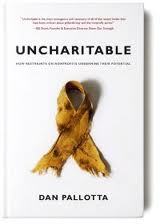 Tuesday’s post “Does your non-profit organization make a difference? Americans don’t think so!” introduced one of the main points in Dan Pallotta’s book Uncharitable, which is that non-profit organizations are under-resourced thus have a difficult time driving results and change. Pallotta argues that the reasons for too few resources are cultural, attitudinal and legal. Yesterday’s post explored what this author believes is at the heart of the non-profit sector’s dilemma. Today, we’re talking about what to do about all of this.
Tuesday’s post “Does your non-profit organization make a difference? Americans don’t think so!” introduced one of the main points in Dan Pallotta’s book Uncharitable, which is that non-profit organizations are under-resourced thus have a difficult time driving results and change. Pallotta argues that the reasons for too few resources are cultural, attitudinal and legal. Yesterday’s post explored what this author believes is at the heart of the non-profit sector’s dilemma. Today, we’re talking about what to do about all of this.
I must admit that Uncharitable was a page turner for me. The more I read, the more I found myself thinking: ” Hmmm . . . I wonder how he suggests we overcome that challenge.” So, words cannot express my disappointment when I got to the chapter where solutions seemingly would be forthcoming and read the following:
“Some readers might expect that in this final chapter I would suggest some dramatic statutory re-engineering — the end of the entire not-for-profit tax-exempt classification or something on that scale. But that is to put the cart before the horse. Even sweeping and fundamental statutory revisions are of secondary importance to changing the way we think about charity.”
After putting the book down and drowning my disappointment in another cup of coffee, I decided to embrace this anticlimactic end to Pallotta’s book. In the final analysis, he is right. Of all the obstacles in the non-profit sector’s way of embracing capitalism and a free-market approach to charity, almost all of them are attitudinal and behavioral barriers and very few of them are structural (e.g. laws and regulations).
At the beginning of every chapter, Pallotta starts it with an inspirational quotation designed to summarize the content of that chapter as well as inspire thought on the part of the reader. One of the quotations was from John Kenneth Galbraith:
“All successful revolutions are the kicking in of a rotten door.”
From this thought, I take my inspiration for today’s blog post. Since most of this rotten door can be kicked in by changing our beliefs and actions, I thought I would share a few of my thoughts on what typical non-profit organizations can start doing to revolutionize the non-profit sector and embrace capitalism and free market solutions to solve our resource challenges.
Engage donors in this discussion
 Penelope Burk tells us to become more donor-centered in our approach to fundraising. Her point of view is centered around the donor, and I think it provides the starting point for this revolution.
Penelope Burk tells us to become more donor-centered in our approach to fundraising. Her point of view is centered around the donor, and I think it provides the starting point for this revolution.
There is nothing stopping you from forming an Oprah-inspired book club with your most influential donors. Buy a copy of Dan Pallotta’s book Uncharitable for each of them. Meet with them after reading each chapter. Facilitate a conversation about what it means and what they think your agency should do about it and what it means for their personal approach to charitable giving.
Budget for a profit
 There is no law that says your non-profit organization can’t make more money than it spends each year. Stop building budgets that don’t include profit. My suggestion is that you set aside 10 percent of your annual revenue every year for the rest of your agency’s life.
There is no law that says your non-profit organization can’t make more money than it spends each year. Stop building budgets that don’t include profit. My suggestion is that you set aside 10 percent of your annual revenue every year for the rest of your agency’s life.
What should this money be used for? Well, that is a discussion for your board of directors to have. So, facilitate it! Some possible ideas include: building a rainy day fund (because you know that storm clouds are always on the horizon), saving for future project, or investing in capacity building and organizational development projects. The sky is limit, and board members need to engage in this conversation to make it realistic and plausible.
Use the power of the markets
 In addition to building a rainy day fund with your excess profits, every non-profit agency should have an endowment strategy. Investing money with the intent of creating another revenue stream stemming from investment income has been a non-profit best practice for a very long time. Use capitalism and the capital markets to generate money for your mission.
In addition to building a rainy day fund with your excess profits, every non-profit agency should have an endowment strategy. Investing money with the intent of creating another revenue stream stemming from investment income has been a non-profit best practice for a very long time. Use capitalism and the capital markets to generate money for your mission.
You don’t need millions of dollars to start an endowment. You can start small and make it a policy or practice to reinvest your earned income back into the endowment.
Yes, of course . . . create a stand along investment committee and set-up policies to guide your agency. This can all start happening tomorrow if you just put your mind to doing it. No one is stopping you.
Follow in Pallotta’s footsteps
 Dan Pallotta founded Pallotta TeamWorks. His for-profit company created, planned and implemented the world-famous AIDS Rides and Breast Cancer 3-Day events. His company netted hundreds of millions of dollars for the expressed purpose of funding non-profit organizations.
Dan Pallotta founded Pallotta TeamWorks. His for-profit company created, planned and implemented the world-famous AIDS Rides and Breast Cancer 3-Day events. His company netted hundreds of millions of dollars for the expressed purpose of funding non-profit organizations.
Form a strategic alliance with other non-profits in your community and look at starting a for-profit company with the intent of running a few high-profile special events. This for-profit event planning and management company would not be constrained by rules and laws that strangle your current efforts.
If you are thinking that Pallotta TeamWorks ended up failing and this is a crazy idea, I encourage you to think again. Sure, Pallotta’s company failed, but it left behind an impressive blueprint. I am suggesting that you are smart enough to engage other non-profit professionals and volunteers in your community to review this case study and use those things that work as well as fix those things that didn’t work.
In the back of the book, there is an entire chapter titled “Case Study — Pallotta TeamWorks“. Is there any harm in pulling a group together, reading the case study and talking through questions associated with ‘What if”?
Pallotta has, of course, started up a new for-profit company focused around the points he makes in his book. Click here to learn more about the company he calls “Change Course”.
Many more ideas and your thoughts
Since most of Pallotta’s proposed revolution is rooted in attitudinal and behavioral change, the sky is the limit. He suggests that you start compensating your employees better and attracting more qualified applicants. He suggests investing in advertising. He proposes removing charity watchdog group logos from your letterhead and website.
Like Saturday Night Live’s character Stuart Smalley used to say: “I’m Good Enough, I’m Smart Enough, and Doggone It, People Like Me!” You and your volunteers and your fellow non-profit professionals and their volunteers are smart enough to come up with many more ideas on how the non-profit sector and your agencies can utilize the power of capitalism to monetize your mission.
So, stop thinking about it and start taking some baby steps towards doing it!
Please scroll down and share one idea or thought that you’ve had while reading the last few days worth of blog posts. Let’s engage in doing some brainstorming and start a revolution.
Here’s to your health!
Erik Anderson
Founder & President, The Healthy Non-Profit LLC
www.thehealthynonprofit.com
erik@thehealthynonprofit.com
http://twitter.com/#!/eanderson847
http://www.facebook.com/eanderson847
http://www.linkedin.com/in/erikanderson847
